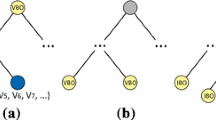Abstract
We present a practical and new hidden-line elimination technique for displaying the perspective view of a scene of three-dimensional isothetic parallelepipeds (3D-rectangles). We assume that the 3D-rectangles are totally ordered based upon the dominance relation of occlusion. The perspective view is generated incrementally, starting with the closest 3D-rectangle and proceeding away from the viewpoint. Our algorithm is scene-sensitive and uses O((n+d) log n log log n) time, where n is the number of 3D-rectangles and d is the number of edges of the display. This improves over the heretofore best known technique. The primary data structure is an efficient alternative to dynamic fractional cascading for use with augmented segment and range trees when the universe is fixed beforehand. It supports queries in O((log n+k) log log n) time, where k is the size of the output, and insertions and deletions in O(log n log log n) time, all in the worst case.
extended abstract
Support was provided in part by NSF research grant CCR-8906419. Part of this research was done while visiting Ecole Normale Supérieure in Paris, France.
Support was provided in part by NSF Presidential Young Investigator Award CCR-8947808 with matching funds from an IBM research contract and by NSF research grant DCR-8403613. Part of this research was done while visiting Ecole Normale Supérieure in Paris, France.
Support was provided by CNRS.
Preview
Unable to display preview. Download preview PDF.
Similar content being viewed by others
References
M. J. Atallah & M. T. Goodrich, “Output-sensitive Hidden Surface Elimination for Rectangles,” Johns Hopkins University, Technical Report CS-88-13, 1988.
M. J. Atallah, M. T. Goodrich & M. Overmars, “New Output-Sensitive Methods for Rectilinear Hidden-Surface Removal,” Department of Computer Science, The Johns Hopkins University, Technical Report 89-09, 1989.
M. Bern, “Hidden Surface Removal for Rectangles,” Journal of Comp. Sys. Sci. (to appear 1990).
P. van Emde Boas, R. Kaas & E. Zijlstra, “Design and Implementation of an Efficient Priority Queue,” Mathematical Systems Theory 10 (1977), 1977.
B. Chazelle, “Filtering Search: A New Approach to Query-Answering,” 24th IEEE Symposium on Foundations of Computer Science, Tucson, Arizona (November 1983).
B. M. Chazelle & L. J. Guibas, “Fractional Cascading I: A Data Structuring Technique,” Algorithmica 1 (1986), 133–162.
R. Cole, “Searching and Storing Similar Lists,” Journal of Algorithms 7 (1986), 202–220.
H. Edelsbrunner, L.J. Guibas & J. Stolfi, “Optimal Point Location in a Monotone Subdivision,” SIAM Journal on Computing 15 (1986), 317–340.
J. D. Foley, A. van Dam, S. K. Feiner & J. F. Hughes, Computer Graphics: Principles and Practice, Addison-Wesley, Reading, MA, 1990.
L. J. Guibas & F. F. Yao, “Translating a Set of Rectangles,” in Advances in Computing Research, Volume 1: Computational Geometry, F. P. Preparata, ed., JAI Press Inc., 1983, 61–78.
R. H. Güting & T. H. Ottmann, “New Algorithms for Special Cases of the Hidden Line Elimination Problem,” Computer Vision, Graphics, and Image Processing 40 (1987).
H. Imai & T. Asano, “Dynamic Orthogonal Segment Intersection Search,” Journal of Algorithms 8 (1987), 1–18.
D. B. Johnson, “A Priority Queue in Which Initialization and Queue Operations Take O(log log D) Time,” Mathematical Systems Theory 15 (1982), 295–309.
K. Mehlhorn & S. Näher, “Dynamic Fractional Cascading,” preprint 1987.
S. Näher, K. Mehlhorn & C. Uhrig, Universität des Saarlandes, Technical Report A 02/90, 1990.
W. M. Newman & R. E. Sproull, Principles of Interactive Computer Graphics, McGraw-Hill, New York, 1979.
F. P. Preparata & D. T. Lee, “Parallel Batch Planar Point Location on the CCC,” Information Processing Letters (to appear).
F. P. Preparata & M. I. Shamos, Computational Geometry, Springer-Verlag, New York, 1985.
F. P. Preparata, J. S. Vitter & M. Yvinec, “Computation of the Axial View of a Set of Isothetic Parallelepipeds,” ACM Transactions on Graphics (to appear 1990).
J. H. Reif & S. Sen, “An Efficient Output-Sensitive Hidden-Surface Removal Algorithm and its Parallelization,” Proceedings of the Fourth Annual ACM Symposium on Computational Geometry (June 1988).
Author information
Authors and Affiliations
Editor information
Rights and permissions
Copyright information
© 1990 Springer-Verlag Berlin Heidelberg
About this paper
Cite this paper
Preparata, F.P., Vitter, J.S., Yvinec, M. (1990). Output-sensitive generation of the perspective view of isothetic parallelepipeds. In: Gilbert, J.R., Karlsson, R. (eds) SWAT 90. SWAT 1990. Lecture Notes in Computer Science, vol 447. Springer, Berlin, Heidelberg. https://doi.org/10.1007/3-540-52846-6_79
Download citation
DOI: https://doi.org/10.1007/3-540-52846-6_79
Published:
Publisher Name: Springer, Berlin, Heidelberg
Print ISBN: 978-3-540-52846-3
Online ISBN: 978-3-540-47164-6
eBook Packages: Springer Book Archive




